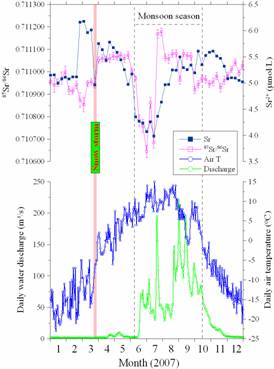Global biogeochemical cycles are of high interest given how little we know about global scale carbon budgets and catchment scale weathering processes. Eolian dust has also potential but uncertain impacts on dissolved load budgets of river/sea water chemistry. However, there is less information about the spatial and temporal controls on the rates and processes of chemical weathering within various catchments. Research which examines large catchments and regions subject to projected climate change is also of high relevance.
Prof. JIN Zhangdong of Institute of Earth Environment, CAS and his international colleaguesfirstly demonstrate the potential contribution of eolian input to the dissolved load of semi-arid inland rivers, on the basis of high precision dissolved chemistry of river water samples collected weekly from the Buha River within the Lake Qinghai catchment. The main concluding remarks include (1) a sensitive response of carbonate versus silicate weathering sources to hydrological forcing on a seasonal basis, (2) eolian dust may affect river water chemistry significantlyand might trigger secondary carbonate precipitation, and (3) a constant silicate contribution to river water chemistry during the dry seasons results from a continued contribution from groundwater.
Related paper entitled “Seasonal contributions of catchment weathering and eolian dust to river water chemistry, northeastern Tibetan Plateau: Chemical and Sr isotopic constraints” by Jin Z D, You C F, Yu J M, Wu L L, Zhang F & Liu H C is published in Journal of Geophysical Research-Earth Surface (116, F04006, doi:10.1029/2011JF002002).

Weekly variations in Sr2+ concentrations and 87Sr/86Sr ratio of the Buha River waters during 2007. Daily water discharge and air temperature are shown for correlating the seasons.
 © 2015 Institute of Earth Environment,CAS
© 2015 Institute of Earth Environment,CAS Address:No. 97 Yanxiang Road, Xi'an 710061, Shaanxi, China

 Location :
Location :